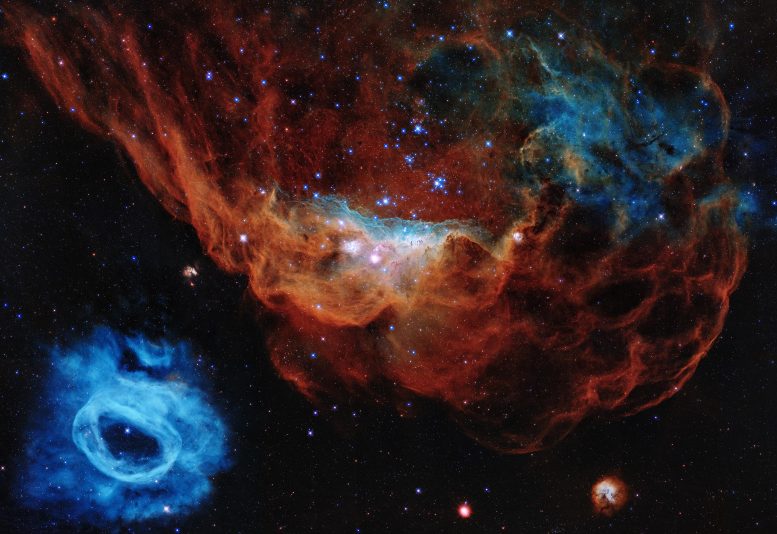
A colorful image resembling a cosmic version of an undersea world teeming with stars is being released to commemorate the Hubble Space Telescope’s 30 years of viewing the wonders of space. In the Hubble portrait, the giant red nebula (NGC 2014) and its smaller blue neighbor (NGC 2020) are part of a vast star-forming region in the Large Magellanic Cloud, a satellite galaxy of the Milky Way, located 163,000 light-years away. The image is nicknamed the “Cosmic Reef,” because NGC 2014 resembles part of a coral reef floating in a vast sea of stars. Some of the stars in NGC 2014 are monsters. The nebula’s sparkling centerpiece is a grouping of bright, hefty stars, each 10 to 20 times more massive than our Sun. The seemingly isolated blue nebula at lower left (NGC 2020) has been created by a solitary mammoth star 200,000 times brighter than our Sun. The blue gas was ejected by the star through a series of eruptive events during which it lost part of its outer envelope of material. Credit: NASA, ESA, and STScI
NASA is celebrating the Hubble Space Telescope’s 30 years of unlocking the beauty and mystery of space by unveiling a stunning new portrait of a firestorm of starbirth in a neighboring galaxy.
In this Hubble portrait, the giant red nebula (NGC 2014) and its smaller blue neighbor (NGC 2020) are part of a vast star-forming region in the Large Magellanic Cloud, a satellite galaxy of the Milky Way, located 163,000 light-years away. The image is nicknamed the “Cosmic Reef,” because it resembles an undersea world.
On April 24, 2020, the Hubble Space Telescope celebrates its 30th year in orbit by premiering a never-before-seen view of two beautiful nebulas named NGC 2020 and NGC 2014. Hubble’s senior project scientist, Dr. Jennifer Wiseman, takes us on a tour of this stunning new image, describes the telescope’s current health, and summarizes some of Hubble’s contributions to astronomy during its 30-year career. Credit: NASA’s Goddard Space Flight Center
Hubble’s top accomplishments include measuring the expansion and acceleration rate of the universe; finding that black holes are common among galaxies; characterizing the atmospheres of planets around other stars; monitoring weather changes on planets across our solar system; and looking back in time across 97% of the universe to chronicle the birth and evolution of stars and galaxies.
Hubble has yielded to date 1.4 million observations and provided data that astronomers around the world have used to write more than 17,000 peer-reviewed scientific publications, making it the most prolific space observatory in history. Its archival data alone will fuel future astronomy research for generations to come.
Hubble’s longevity can be attributed to five space shuttle servicing missions, from 1993 to 2009, in which astronauts upgraded the telescope with advanced instruments, new electronics and on-orbit repairs. The venerable observatory, with its suite of cameras and other instruments, is expected to stay operational through the 2020s, in synergy with the upcoming James Webb Space Telescope.
For more on Hubble’s 30th Anniversary, including more pictures and videos, see:
- Hubble Celebrates Its 30th Anniversary With a Turbulent Tapestry of Blazing Starbirth
- Revealed: Hubble Space Telescope’s Jaw-Dropping 30th Anniversary Image
The Hubble Space Telescope is a project of international cooperation between NASA and ESA (the European Space Agency). NASA’s Goddard Space Flight Center in Greenbelt, Maryland, manages the telescope. The Space Telescope Science Institute (STScI) in Baltimore conducts Hubble science operations. STScI is operated for NASA by the Association of Universities for Research in Astronomy in Washington, D.C.

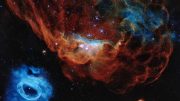
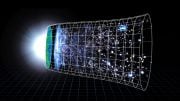


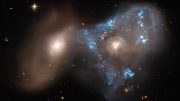
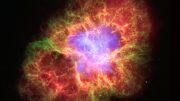
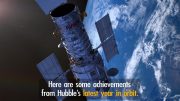
Be the first to comment on "Turbulent Firestorm of Starbirth Captured in Awe-Inspiring Hubble 30th Anniversary Portrait"